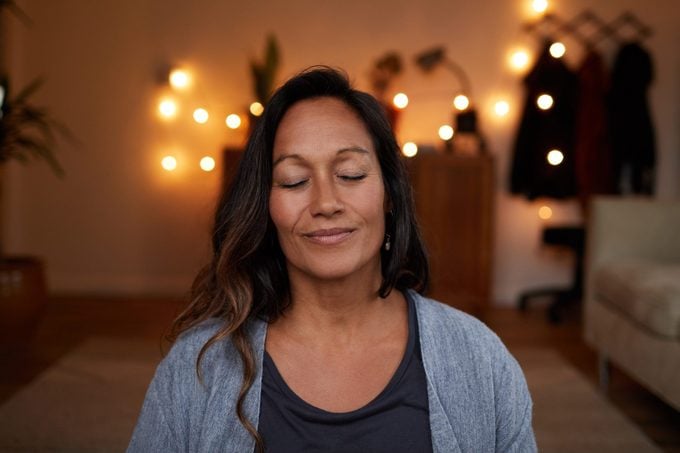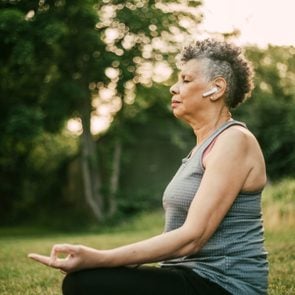What Is RAIN Meditation—and Should You Try It?
Updated: Jun. 02, 2021
Feeling overwhelmed or anxious? Done with tearing yourself down? RAIN meditation may be exactly what you need to get out of your own way.
Don’t be afraid of a little RAIN
If your mental health has taken a beating over the past year, you’re not alone. One report from the Centers for Disease Control and Prevention found that 40 percent of Americans said they struggled with at least one negative mental health condition. No wonder, considering the ongoing Covid-19 pandemic.
That may be why so many people have turned to meditation.
Meditation is helping millions of people find their inner confidence and compassion, and RAIN meditation, in particular, can offer some important benefits for people who are struggling with insecurity, anxiety, anger, or other not-so-helpful emotions.
When you feel like a cloud is hanging over your head, get ready for some RAIN.
What is RAIN meditation?
Before you can understand this particular branch of meditation, it helps to know what meditation is on a whole.
Meditation is an umbrella term for a set of techniques that encourage a heightened state of consciousness, largely by focusing on the here and now. It confers a host of potential mental and physical health benefits, including lower blood pressure, less anxiety, and decreased pain.
RAIN—recognize, accept, investigate, and non-identification—is just one type of meditation. It was created by mindfulness teacher Michele McDonald, the cofounder of Vipassana Hawai’i in Kapaau, Hawaii.
Several psychologists have adapted and expanded on RAIN, including Tara Brach, PhD, a psychologist and meditation teacher in Rockville, Maryland, and the author of Radical Compassion. (With Tara Brach RAIN meditation, the N in RAIN stands for “nurture.”)
“RAIN is a combination of mindfulness and self-compassion that involves four easy steps,” explains Brach.
Making it RAIN
Remembering how to do RAIN meditation is as easy as remembering the handy acronym. Here’s how to do Tara Brach RAIN meditation, as explained by its creator.
Recognize
This is your cue to recognize what you are feeling in the moment. “It’s a mental naming of what is going on,” says Brach.
Maybe you’re anxious, or maybe you’re drowning in sadness, anger, or stress. Perhaps some other emotion is getting in your way.
Accept that feeling
It can be tempting to jump into action once we recognize how we’re feeling. We sense stress, so we quickly try to problem solve. Resist the urge.
“Don’t try to fix it or judge it,” Brach says. “Let it be.”
Investigate
All right, you’re feeling your feelings. That’s good. Now go a step further.
“Take some time to get to know your feelings with interest and care,” Brach says.
Ask yourself: What does it feel like? How are these feelings affecting you?
Nurture
Remember, in Brach’s iteration of RAIN, N stands for “nurture.”
“Offer the part of you that is distressed what it needs to feel comforted,” she says. “Sometimes a gentle touch of your hand on your heart really helps.”
Reflect after RAIN
After you complete the steps to RAIN meditation, pause for a few moments.
“Sense what has shifted, as this can deepen your experience,” Brach says. “You may go from feeling fearful or angry to a space of kindness or compassion.”
How to practice RAIN
Find a quiet place and a comfy position, Brach says. That’ll lessen distractions during your practice. (Most of us can’t quiet our minds when our butts are going numb from the hard ground.)
You don’t need to dedicate a whole lot of time to meditation. Even small bouts can be beneficial.
“RAIN can be short—sometimes just two minutes—or it can take longer if it’s a knotty issue and something you have been struggling with all your life,” Brach adds.
RAIN meditation can be done on your own or with a guided meditation practice. “If you are working to overcome trauma, you will want a therapist to guide you,” Brach says. But “if you are working through an uncomfortable emotion, you can go through the RAIN steps on your own in the moment.”
Like many other mediation practices, you don’t need any special equipment for RAIN, though some people use meditation pillows or other meditation tools to help them focus.
“All we need is already within us. We just have to access it,” McDonald says. “I do think some support, such as listening to a guided meditation or a talk, or attending a group guided meditation, would be helpful.”

RAIN benefits
RAIN meditation offers a host of benefits. When you’re in a negative headspace, doing the practice can help you get centered, calm, and confident. The benefits below are some of the top reasons people say they enjoy RAIN meditation.
Confidence boost
“During the Covid-19 pandemic, many people said that RAIN saved their life,” Brach says. “In the moments of uncertainty, when they would just pause, let it be, and breathe with it for a little bit, RAIN increased the feelings of confidence that they can handle what was going on.”
For many people, RAIN makes the difference between depression and resilience.
Improved self-esteem
RAIN helps boost confidence and self-esteem, Brach says.
“When you get depressed, you turn against yourself, but RAIN can quiet the inner critic,” she says. “It cultivates self-compassion and self-understanding, and when we have those things, we are much less judgmental of ourselves and others.”
(Learn more about practicing meditation for depression.)
Mindfulness support
Mindfulness and RAIN can go hand in hand, she says. “RAIN offers amazing support to other things that you are doing to improve your mental health.”
Better communication
RAIN can also help improve communication within relationships. “If you are going to be spending time with someone who you feel anger toward, calming down with RAIN can help engage in a more understanding and less blaming way,” Brach says.
Brach practices what she preaches.
“At 83, my mother moved to live with me,” she shares. “Those first six months were difficult—I was busy with writing and teaching, and she needed my support in acclimating to a new life. I’d often swing between the stress of anxiety and guilt.”
One day, her mom popped into her office to show her an article, and Brach barely looked up. Her mom quietly left, but Brach was struck by a pang of guilt.
She took a break and used RAIN to calm her immediate fears about getting everything done.
“When I got to the nurturing in RAIN, I reminded myself to trust I wasn’t going to fail—I would be fine in my work and come through in a loving relationship with my mom,” she says. “I felt calmer, more expansive. And over the weeks, I found I was increasingly present with my mom for our walks by the river, our big salads in the evening, for spontaneous laughter and intimate conversations.”
Brach’s mother passed away three years later. “I was filled with grief, but not regrets,” she says. “RAIN had saved my life moments with my mom.”
A DROP of RAIN
RAIN creator McDonald recently enhanced the RAIN acronym to include DROP to better reflect that old habits try to protect us when we want to be more present and practice RAIN. The acronym stands for Delusion/distraction, Resistance, Obliviousness, and Personalization.
Delusion/distraction
If you’ve ever meditated, you probably understand the “distraction” part of the acronym well. Sure, you may be trying to do the recognition part of RAIN, but your brain’s stuck on the way the barista told you to enjoy your latte and you responded, “You too.”
“The truth is, we don’t always want to be present, and we distract ourselves,” she says. “Recognition needs to be stronger than Distraction.”
When you notice these distractions, your breath can be your anchor. “You come to your breath to seek safe harbor and give your brain time to rest before going back to the recognition,” McDonald says.
Resistance
The A in RAIN may stand for acceptance of these emotions, but your mind is bound to resist. Hence the R in DROP.
It can be difficult to allow yourself to be anxious or angry. Push past the resistance to overcome the negative emotions.
Obliviousness
Investigating the emotion or reaction with kindness (the I in RAIN) is the opposite of being oblivious (the O in drop), McDonald says.
Personalization
In McDonald’s version of RAIN, the N stands for natural awareness, and it reminds you to not identify with the emotion, state, or experience.
The bottom line: don’t make it personal, she says.
Anger can exist, but it doesn’t have to be your anger. Instead, look at it in a more impersonal way. “If you let yourself be the possessor, you will hold onto it, but if you are mindful of it, the feeling passes by itself,” McDonald says.
Under the RAIN umbrella
There are a lot of good reasons to give RAIN a go, and thankfully there are a variety of places that offer guided meditations that will help you learn the practice.
Vipassana Hawai’i offers virtual Sunday sittings, which comprise 10- to 15-minute guided RAIN meditations. Brach also offers guided RAIN meditations on her website.
RAIN meditations are also available on many meditation apps, such as Calm.
So should you try it? All you have to lose is a few minutes of your time (and the negative emotions you’ve been carrying around).
It’s easy to learn, requires zero financial investment, and it will complement other self-help techniques. “It’s a way of life,” McDonald says.
Next, learn 10 ways to sneak meditation into your daily life.
















